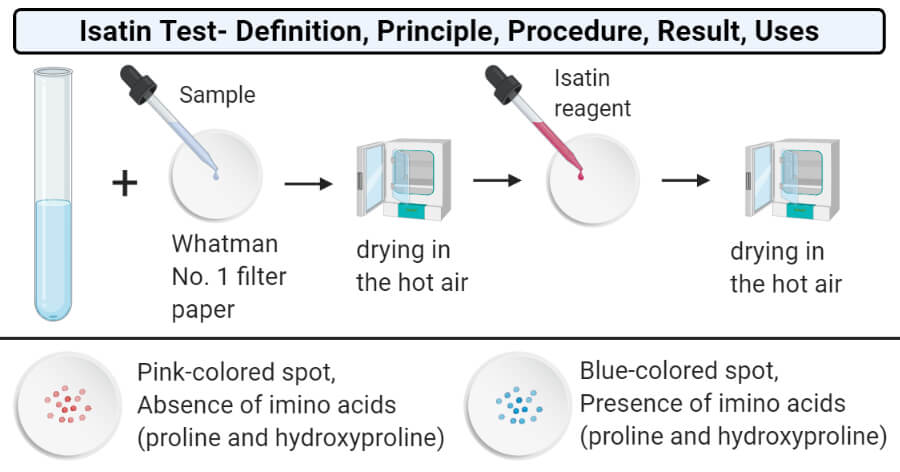Interesting Science Videos
Isatin Test Definition
Isatin test is a biochemical test for the detection of amino acids like proline and hydroxyproline. The test is a specific test for specific amino acids that produces a colored addition product (also called adduct) with the Isatin reagent. The detection of imino acid proline for a long time had been unsatisfactory as methods like the ninhydrin test can only detect proline after isolation from other amino acids. Later in 1971, Fouad N. Boctor came up with a reaction between proline and isatin which can be used to qualitatively and quantitatively determine the amount of proline. The distinction between proline and hydroxyproline cannot be made by this test as isatin reacts with both of the compounds to produce a colored product.
Objectives of Isatin Test
- To detect the presence of proline and hydroxyproline-containing proteins in a sample.
- To distinguish proline and hydroxyproline from other amino acids.
Principle of Isatin Test
Isatin reagent used in the test works as a visualizing agent that provides different colors with different amino acids in the chromatography technique. The isatin reaction between proline and hydroxyproline produces a characteristic blue-colored product. The reaction between imino acids like proline and hydroxyproline and isatin (1H-indole-2,3-dione) yields a blue-colored adduct. The reaction is a simple addition reaction where the combination of isatin and proline produces a colored product, indicating the presence of imino acids.
Requirements
Reagent
- Isatin reagent: A 0.02% solution of isatin is prepared by dissolving isatin crystals in 0.5 M sodium citrate buffer at the pH ranging from 3 to 11.
- Sample
- Concentrated HCl
Materials required
- Whatman No. 1 filter paper
- Hot air oven
- Pipettes
Procedure of Isatin Test
- A drop of the sample (imino acid) solution is added to a Whatman No. 1 filter paper and dried by placing it in a hot air oven.
- Now, a drop of isatin reagent is added to the dried spot, and the process of drying in the hot air oven is repeated.
- The paper is then observed for the formation of a blue-colored spot.
Result and Interpretation of Isatin Test

- Positive result: A positive result of the Istain test is represented by the formation of a blue-colored spot on the filter paper. This indicates the presence of imino acids.
- Negative result: A negative result of the Isatin test is represented by the formation of a pink-colored spot on the filter paper. This indicates the absence of imino acids.
Uses of Isatin Test
- The test is used for the detection of proline and hydroxyproline amino acids in a sample solution.
- Isatin test is one of the standard tests for the detection of polynuclear hydrocarbons and phenols in polluted air.
- The method is simple, fast, and suitable for the estimation of proline content in larger samples.
Limitations
- The color observed in the test should be observed carefully, and the test should be repeated if a mixed color is observed.
References
- Elliott RJ, Gardner DL. Proline determination with isatin, in the presence of amino acids. Anal Biochem. 1976 Jan;70(1):268-73. DOI: 10.1016/s0003-2697(76)80068-1. PMID: 3990.
- Ábrahám, Edit & Cabassa, Cécile & Erdei, László & Szabados, László. (2010). Methods for Determination of Proline in Plants. Methods in molecular biology (Clifton, N.J.). 639. 317-31. 10.1007/978-1-60761-702-0_20.
- Sawicki, E., Stanley, T. W., Hauser, T. R., & Barry, R. (1959). Isatin Tests for Aromatic Hydrocarbons and Phenols. Analytical Chemistry, 31(10), 1664–1667.doi:10.1021/ac60154a034
- Boctor, F. N. (1971). An improved method for colorimetric determination of proline with isatin. Analytical Biochemistry, 43(1), 66–70.doi:10.1016/0003-2697(71)90108-4
- Tiwari, A. (2015). Practical Biochemistry. LAP Lambert Academic Publishing.
